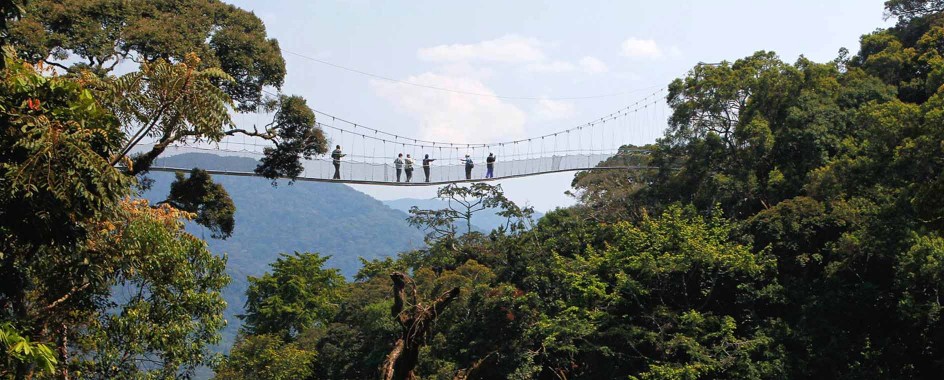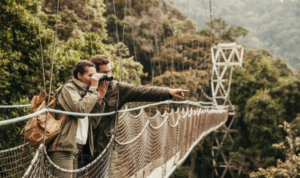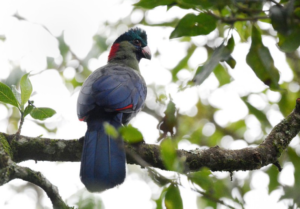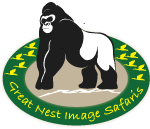Nyungwe Forest National Park
Nyungwe Forest National Park : is one of the oldest rain forests in Africa as well as rich in biodiversity and spectacularly beautiful. The mountainous region is teaming with wildlife, including a small population of chimpanzees as well as 12 other species of primate. Primate tracking tops most visitor’s list, and it’s worth lingering a little longer for those with time to relax and take in the primal atmosphere.
Bird watching is also among the best activity with over 322 bird species including Red-collared babbler and 29 other Albertine Rift endemic species. Besides, there are over 75 mammals in this park, such as the serval cat, mongoose, Congo clawless otter, leopard, etc. Memorable and photogenic moments include walking up to the Isumo waterfall or along the Canopy walk suspension bridge. Tea plantation border the edges of the park, with a habituated troop of Ruwenzori colobus monkeys at Gisakura as well as forest fringe birds.

What do to in Nyungwe Forest National Park
Chimpanzee tracking
 The park is a home of two habituated Chimpanzee groups i.e. one found at Uwunika while the other at cyamudongo. As a matter a fact, this activity makes it the most interesting activity in this park. Besides, there are number of trails that can be used during this thrilling activity. However, travelers are required to be physically fit since it involves long distances. Here, you get a chance to enjoy different activities, breasting the young ones, how the chimp babies are looked after, how they feed and the plant species they feed on. Therefore, by the time you depart from the park you will be contented with all the information about the chimps. The trekking is usually for 2-7 hours or the hours may increase depending on the location of the chimps since they travel long distances in search for food.
The park is a home of two habituated Chimpanzee groups i.e. one found at Uwunika while the other at cyamudongo. As a matter a fact, this activity makes it the most interesting activity in this park. Besides, there are number of trails that can be used during this thrilling activity. However, travelers are required to be physically fit since it involves long distances. Here, you get a chance to enjoy different activities, breasting the young ones, how the chimp babies are looked after, how they feed and the plant species they feed on. Therefore, by the time you depart from the park you will be contented with all the information about the chimps. The trekking is usually for 2-7 hours or the hours may increase depending on the location of the chimps since they travel long distances in search for food.
Monkey tracking
 This is generally the best place where you can spot over 300 monkey species that are residents in the Park. Primates that thrive in the area include; Ruwenzori colobus, L’Hoest’s monkey, black and white colobus. Silver monkey, Golden monkey, blue monkeys, Hamlyn’s monkey, Red-tailed monkey. Dent’s Mona monkey, Vervet monkey, Grey-cheeked mangabeys among others. Enjoy your monkey adventure as you watch monkeys jumping from one branch of to another as well as entertain you with their lively nature.
This is generally the best place where you can spot over 300 monkey species that are residents in the Park. Primates that thrive in the area include; Ruwenzori colobus, L’Hoest’s monkey, black and white colobus. Silver monkey, Golden monkey, blue monkeys, Hamlyn’s monkey, Red-tailed monkey. Dent’s Mona monkey, Vervet monkey, Grey-cheeked mangabeys among others. Enjoy your monkey adventure as you watch monkeys jumping from one branch of to another as well as entertain you with their lively nature.
Forest canopy walk
 Canopy walk also known as tree top walks basically provides pedestrian access to the forest canopy. The walkway is a bridge-like in nature between trees in the canopy of the Park mostly linked up with platforms inside and around trees. This canopy walk is generally 200metres above the forest with a height of 40metres. In addition, it’s only in Nyungwe forest National Park where this activity is done in the whole of East Africa.
Canopy walk also known as tree top walks basically provides pedestrian access to the forest canopy. The walkway is a bridge-like in nature between trees in the canopy of the Park mostly linked up with platforms inside and around trees. This canopy walk is generally 200metres above the forest with a height of 40metres. In addition, it’s only in Nyungwe forest National Park where this activity is done in the whole of East Africa.
During the activity tourists get an opportunity to originally access the upper regions of forest while viewing and encountering other primates. Some of these include the monkeys moving from branch of tree to the other, as well as bird species. Besides, the canopy walk has got trails but each derives its name according to the tree species in the area. The walk basically lasts for two hours however, there is age restriction whereby tourists below six years are not allowed to be part of the activity for safety purposes.
Hiking
Hiking is a vigorous walk in the footpath of Nyungwe Forest National Park. In fact, the park has over 13 trails which will help you explore the forest, waterfalls, rivers and springs. The hike basically lasts for about 1-8 hours although it requires a traveler to be physically fit. The hiking trails include; Bigugu which enables you to view the hills of DRC and Lake Kivu, Isumo, Karamba-best for birding, Ngabwe, Kamiranzovu, Igishigishigi, among others. However, Bigugu and Igishigishigi are the most popular trails used by tourists. During the hike, tourists are also able to spot different bird species, butterflies, primates, tree species, and other wildlife.
Birding
 The park is generally a home of over 284 bird species that thrive in the area. The bird species include; sunbirds, Rwenzori Turaco, strange weaver, Chapin’s flycatcher, Archer’s robin chat. Blue Turaco, Black and white casqued hornbills, Yellow-eyed black flycatcher, Rwenzori nightjar, Ruwenzori Batis, etc.
The park is generally a home of over 284 bird species that thrive in the area. The bird species include; sunbirds, Rwenzori Turaco, strange weaver, Chapin’s flycatcher, Archer’s robin chat. Blue Turaco, Black and white casqued hornbills, Yellow-eyed black flycatcher, Rwenzori nightjar, Ruwenzori Batis, etc.
How to get to Nyungwe forest
Nyungwe forest National Park is located in South Western Rwanda close to Lake Kivu and Democratic Republic of Congo, with Burundi border in the South. It is located near Cyangungu town, about 225 km and a 4-5-hour drive from Kigali. You can either drive to the park from Kigali, or fly there.
Where to stay
The park has got a lot of lodges, camps & hotels for accommodation ranging from luxury, budget and mid-range. Besides, are available both inside and outside the park. You can book your accommodation through our company and early bookings are advise.
Nyungwe Forest Lodge
This lodge is basically situated in a tea plantation close to Nyungwe forest. It is a 5 star and luxury lodge with some of the best facilities and good services in Rwanda. The lodge also overlooks the forest canopy so you are guaranteed some scenic views of the area. In addition, it has comfortable luxury rooms, with a Jacuzzi board basis and full boards.
Gisakura Guest House
This is a comfortable accommodation for people working with smaller budgets. It is found about 2 km from the park and close to the Gisakura tea estate along the road to Rusizi. The guest house also offers a chance to visit the chimpanzees, bird watching as well as hiking along different trails.
Nyungwe Top View Hotel
This lodge offers good accommodation close to the park. The accommodation here is in red brick cottages furnished with only necessary furniture. The hotel is also connected to electric power grid, and the power is always on, so there is no need of worrying about the dark nights.






